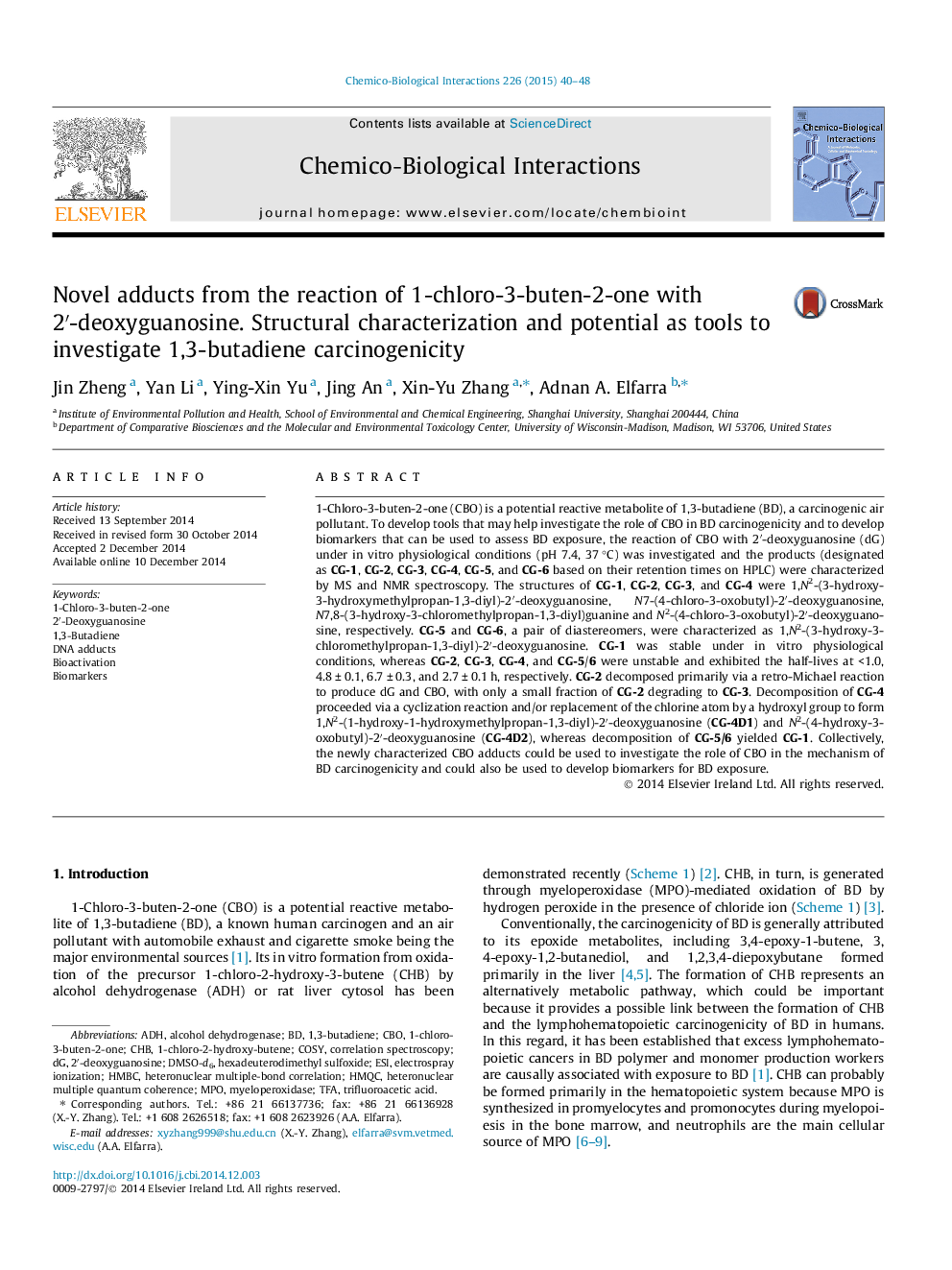| کد مقاله | کد نشریه | سال انتشار | مقاله انگلیسی | نسخه تمام متن |
|---|---|---|---|---|
| 5847973 | 1561615 | 2015 | 9 صفحه PDF | دانلود رایگان |
عنوان انگلیسی مقاله ISI
Novel adducts from the reaction of 1-chloro-3-buten-2-one with 2â²-deoxyguanosine. Structural characterization and potential as tools to investigate 1,3-butadiene carcinogenicity
دانلود مقاله + سفارش ترجمه
دانلود مقاله ISI انگلیسی
رایگان برای ایرانیان
کلمات کلیدی
ESIDMSO-d6HMQCCHBCBODNA adductsTFAADH1,3-Butadiene - 1،3-بوتادین2′-deoxyguanosine - 2'-deoxyguanosineMPO - DFOTrifluoroacetic acid - اسید TrifluoroaceticAlcohol dehydrogenase - الکل دهیدروژنازheteronuclear multiple quantum coherence - انسجام کوانتومی چند گانه هسته ایcorrelation spectroscopy - طیف سنجی همبستگیBioactivation - فعال سازی بیولوژیکmyeloperoxidase - میلوپراکسیداز Biomarkers - نشانگر زیستی یا بیومارکرHMBC یا Heteronuclear Multiple Bond Correlation - همبستگی پیوند چندگانه ناجورهستهheteronuclear multiple-bond correlation - همبستگی چند باند هترو هسته ایCOSY - کثیفelectrospray ionization - یونیزاسیون الکترو اسپری
موضوعات مرتبط
علوم زیستی و بیوفناوری
علوم محیط زیست
بهداشت، سم شناسی و جهش زایی
پیش نمایش صفحه اول مقاله

چکیده انگلیسی
1-Chloro-3-buten-2-one (CBO) is a potential reactive metabolite of 1,3-butadiene (BD), a carcinogenic air pollutant. To develop tools that may help investigate the role of CBO in BD carcinogenicity and to develop biomarkers that can be used to assess BD exposure, the reaction of CBO with 2â²-deoxyguanosine (dG) under in vitro physiological conditions (pH 7.4, 37 °C) was investigated and the products (designated as CG-1, CG-2, CG-3, CG-4, CG-5, and CG-6 based on their retention times on HPLC) were characterized by MS and NMR spectroscopy. The structures of CG-1, CG-2, CG-3, and CG-4 were 1,N2-(3-hydroxy-3-hydroxymethylpropan-1,3-diyl)-2â²-deoxyguanosine, N7-(4-chloro-3-oxobutyl)-2â²-deoxyguanosine, N7,8-(3-hydroxy-3-chloromethylpropan-1,3-diyl)guanine and N2-(4-chloro-3-oxobutyl)-2â²-deoxyguanosine, respectively. CG-5 and CG-6, a pair of diastereomers, were characterized as 1,N2-(3-hydroxy-3-chloromethylpropan-1,3-diyl)-2â²-deoxyguanosine. CG-1 was stable under in vitro physiological conditions, whereas CG-2, CG-3, CG-4, and CG-5/6 were unstable and exhibited the half-lives at <1.0, 4.8 ± 0.1, 6.7 ± 0.3, and 2.7 ± 0.1 h, respectively. CG-2 decomposed primarily via a retro-Michael reaction to produce dG and CBO, with only a small fraction of CG-2 degrading to CG-3. Decomposition of CG-4 proceeded via a cyclization reaction and/or replacement of the chlorine atom by a hydroxyl group to form 1,N2-(1-hydroxy-1-hydroxymethylpropan-1,3-diyl)-2â²-deoxyguanosine (CG-4D1) and N2-(4-hydroxy-3-oxobutyl)-2â²-deoxyguanosine (CG-4D2), whereas decomposition of CG-5/6 yielded CG-1. Collectively, the newly characterized CBO adducts could be used to investigate the role of CBO in the mechanism of BD carcinogenicity and could also be used to develop biomarkers for BD exposure.
ناشر
Database: Elsevier - ScienceDirect (ساینس دایرکت)
Journal: Chemico-Biological Interactions - Volume 226, 25 January 2015, Pages 40-48
Journal: Chemico-Biological Interactions - Volume 226, 25 January 2015, Pages 40-48
نویسندگان
Jin Zheng, Yan Li, Ying-Xin Yu, Jing An, Xin-Yu Zhang, Adnan A. Elfarra,